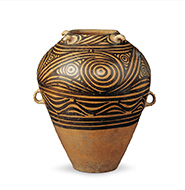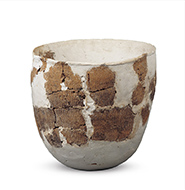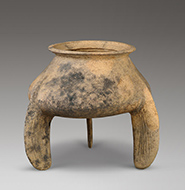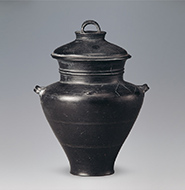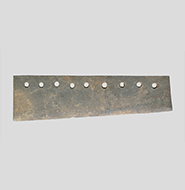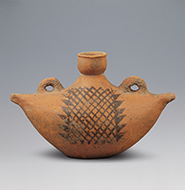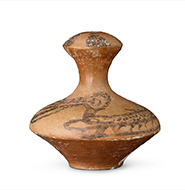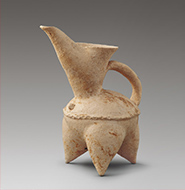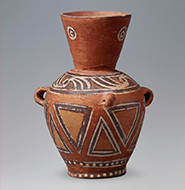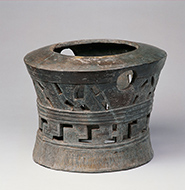Prehistoric Times
(c. 2 million years ago–c. 21st century BC)I Lower Palaeolithic China
The Lower Palaeolithic dates from about 2 million to 200,000 years ago. During that period, the early human species called Homo erectus lived in China. Early fossils discovered at numerous locations indicate that China was a key area of activity in human evolution. The earliest Homo erectus found in China, Yuanmou Man, lived about 1.7 million years ago. Somewhat later, Lantian Man, Peking Man, Yunxian Man, Hexian Man, and Tangshan Man emerged in other regions. Homo erectus used chipped stone tools and wooden sticks for hunting and gathering and also knew how to use and manage fire.
- Upper Incisors of Yuanmou Man (replicas)
Lower Palaeolithic, c. 1.7 million years ago - Lantian Man Skull (replica)
Lower Palaeolithic, c. 1.15–1.1 million years ago - Peking Man Carrying a Deer
By Yang Heting, 1950 - Peking Man Skull (replica)
Lower Palaeolithic, c. 280,000–230,000 years ago - Reconstruction of Peking Man
By Wang Cunyi under the guidance of Wu Rukang and Wu Xinzhi, 195 - Yunxian Man Skull (replica)
Lower Palaeolithic, c. 1 million–900,000 years ago - Stone Scraper and Points (replicas)
Lower Palaeolithic (c. 2 million–200,000 years ago) - Stone Chopper
Lower Palaeolithic (c. 2 million–200,000 years ago) - Hammerstone and Stone Anvils
Lower Palaeolithic (c. 2 million–200,000 years ago)
- Bipolar Stone Flakes
Lower Palaeolithic (c. 2 million–200,000 years ago) - Stone Scrapers and Point
Lower Palaeolithic (c. 2 million–200,000 years ago) - Stone Choppers
Lower Palaeolithic (c. 2 million–200,000 years ago) - Stone End Choppers
Lower Palaeolithic (c. 2 million–200,000 years ago) - Burnt Stones
Lower Palaeolithic (c. 2 million–200,000 years ago) - Cinder Fragments
Lower Palaeolithic (c. 2 million–200,000 years ago) - Burnt Earth
Lower Palaeolithic (c. 2 million–200,000 years ago) - Charred Animal Bones
Lower Palaeolithic (c. 2 million–200,000 years ago) - Charred Sandgrouse Bones and Other Bird Bones
Lower Palaeolithic (c. 2 million–200,000 years ago)
- Hackberry Seeds
Lower Palaeolithic (c. 2 million–200,000 years ago) - Sabre-toothed Tiger Skull and Eyetooth (replicas)
Lower Palaeolithic (c. 2 million–200,000 years ago) - Thick-jawed Deer Antler and Lower Jawbone
Lower Palaeolithic (c. 2 million–200,000 years ago) - Pseudaxis grayi Antler and Lower Jawbone
Lower Palaeolithic (c. 2 million–200,000 years ago) - Rodent Bone Chips
Lower Palaeolithic (c. 2 million–200,000 years ago) - Ostrich Eggshell Fragments
Lower Palaeolithic (c. 2 million–200,000 years ago) - Hamster Lower Jawbones
Lower Palaeolithic (c. 2 million–200,000 years ago) - Wild Pigeon Humeri
Lower Palaeolithic (c. 2 million–200,000 years ago) - Rabbit and Badger Skulls and Antelope Antlers
Lower Palaeolithic (c. 2 million–200,000 years ago)
II Middle and Upper Palaeolithic China
The Middle and Upper Palaeolithic can be traced from about 200,000 to 10,000 years ago when the human species Homo sapiens emerged. Many fossils belonging to Homo sapiens have been discovered across China, including Jinniushan Man, Dali Man, Xujiayao Man, Dingcun Man, Maba Man, Liujiang Man, Xuchang Man, Upper Cave Man, and Zuozhen Man. This period is characterized by progress in stone tool technology and wider use of stone balls in hunting. The Upper Palaeolithic saw the invention of javelins, harpoons, bows, and arrows––indicating an economy based on fishing and hunting––as well as the birth of early beliefs and art.
- Jinniushan Man Skull (replica)
Middle Palaeolithic, c. 280,000 years ago - Maba Man Skull (replica)
Middle Palaeolithic, c. 140,000 years ago - Liujiang Man Skull (replica)
Middle Palaeolithic, c. 70,000 years ago - Upper Cave Man Skull (replica)
Upper Palaeolithic, c. 30,000 years ago - Reconstruction of Upper Cave Man
Adaptation by Wang Cunyi, 1950s - Stone Triangular Point and Heavy Triangular Point
Middle Palaeolithic (c. 200,000–50,000 years ago) - Stone Chopper and Scrapers
Middle Palaeolithic (c. 200,000–50,000 years ago) - Stone Bolas
Middle Palaeolithic (c. 200,000–50,000 years ago) - Stone Bolas
Middle Palaeolithic (c. 200,000–50,000 years ago) - Bovine Horn
Middle Palaeolithic (c. 200,000–50,000 years ago) - Stone Scrapers and Flakes
Middle Palaeolithic (c. 200,000–50,000 years ago) - Stone Scrapers
Middle Palaeolithic (c. 200,000–50,000 years ago) - Stone Flakes and Single-platform Core
Middle Palaeolithic (c. 200,000–50,000 years ago) - Stone Drill (replica)
Upper Palaeolithic (c. 50,000–10,000 years ago) - Stone Scrapers and Points (replicas)
Upper Palaeolithic (c. 50,000–10,000 years ago) - Stone Scrapers and Points
Upper Palaeolithic (c. 50,000–10,000 years ago) - Stone Cores
Upper Palaeolithic (c. 50,000–10,000 years ago) - Stone Scrapers and Points
Upper Palaeolithic (c. 50,000–10,000 years ago) - Stone Point
Upper Palaeolithic (c. 50,000–10,000 years ago)
- Stone Flakes
Upper Palaeolithic (c. 50,000–10,000 years ago) - Stone Microcores
Upper Palaeolithic (c. 50,000–10,000 years ago) - Stone Microcore and Microblades (replicas)
Upper Palaeolithic (c. 50,000–10,000 years ago) - Stone Points and Burins
Upper Palaeolithic (c. 50,000–10,000 years ago) - Stone Backed Knives
Upper Palaeolithic (c. 50,000–10,000 years ago) - Stone Scrapers
Upper Palaeolithic (c. 50,000–10,000 years ago) - Stone Spearhead
Upper Palaeolithic (c. 50,000–10,000 years ago) - Stone Microcores, Microblades, and Drill
Upper Palaeolithic (c. 50,000–10,000 years ago) - Stone Flake
Upper Palaeolithic (c. 50,000–10,000 years ago) - Stone Scrapers and Point
Upper Palaeolithic (c. 50,000–10,000 years ago) - Stone Points
Upper Palaeolithic (c. 50,000–10,000 years ago) - Reconstruction of an Early Bow and Arrow
- Stone Arrowhead (replica)
Upper Palaeolithic (c. 50,000–10,000 years ago) - Stone Arrowheads
Upper Palaeolithic (c. 50,000–10,000 years ago) - Bone Harpoon (replica)
Upper Palaeolithic (c. 50,000–10,000 years ago) - Bone Harpoon (replica)
Upper Palaeolithic (c. 50,000–10,000 years ago) - Carp Vertebra (replica)
Upper Palaeolithic, c. 30,000 years ago - Bone Javelin Head (replica)
Upper Palaeolithic (c. 50,000–10,000 years ago) - Bone Needles (replicas)
Upper Palaeolithic (c. 50,000–10,000 years ago)
- Bone Needle (replica)
Upper Palaeolithic, c. 30,000 years ago - Polished Antler (replica)
Upper Palaeolithic, c. 30,000 years ago - Bone Awl (replica)
Upper Palaeolithic (c. 50,000–10,000 years ago) - Bone Spade (replica)
Upper Palaeolithic (c. 50,000–10,000 years ago) - Antler Spade
Upper Palaeolithic (c. 50,000–10,000 years ago) - Bone Piece (replica)
Upper Palaeolithic (c. 50,000–10,000 years ago) - Bone Pieces
Upper Palaeolithic (c. 50,000–10,000 years ago) - Incised Bone Cylinders (replicas)
Upper Palaeolithic, c. 30,000 years ago - Pieces of Hematite (replicas)
Upper Palaeolithic, c. 30,000 years ago - Perforated Animal Teeth (replicas)
Upper Palaeolithic, c. 30,000 years ago - Perforated Animal Teeth and Mussel Shell (replicas)
Upper Palaeolithic (c. 50,000–10,000 years ago) - Pieces of Hematite
Upper Palaeolithic (c. 50,000–10,000 years ago) - Decorative Beads
Upper Palaeolithic (c. 50,000–10,000 years ago) - Antler with Incised Design (replica)
Upper Palaeolithic (c. 50,000–10,000 years ago) - Life of the Upper Cave Man
By Xi Changxi, Liu Shiming, and Liu Xiaocen, 1974
III Life and Production in Neolithic China
The Neolithic Age began about 10,000 years ago. This period featured the advent of agriculture, animal-raising, polished stone tools, and invention of pottery. People began living in settlements by blood relationship and the economy was gradually transformed into a production-based one.
- Pottery Shard Containing Carbonized Rice
Pengtoushan Culture (c. 6500–5400 BC) - Carbonized Rice
Hemudu Culture (c. 5200–4200 BC) - Pottery Bowl Incised with Rice Design (replica)
Hemudu Culture (c. 5200–4200 BC) - Stone Axe
Hemudu Culture (c. 5200–4200 BC) - Bone Spade
Hemudu Culture (c. 5200–4200 BC) - Wooden Spade (replica)
Hemudu Culture (c. 5200–4200 BC) - Stone Knife
Liangzhu Culture (c. 3300–2200 BC) - Stone Pick
Shixia Culture (c. 2900–2700 BC) - Stone Axe
Yuanshan Culture (c. 2400–1100 BC) - Stone Spade
Yuanshan Culture (c. 2400–1100 BC) - Carbonized Millet
Xinle Culture (c. 5300–4800 BC) - Pottery Jar Containing Vegetable Seeds (replica)
Yangshao Culture (c. 5000–3000 BC) - Stone Spade
Peiligang Culture (c. 6100-5000 BC) - Stone Sickle
Peiligang Culture (c. 6100–5000 BC) - Stone Quern and Roller
Peiligang Culture (c. 6100–5000 BC) - Stone Axe
Xinle Culture (c. 5300–4800 BC) - Stone Hoe
Yangshao Culture (c. 5000–3000 BC) - Stone and Pottery Knives
Yangshao Culture (c. 5000–3000 BC) - Antler Pick
Keshengzhuang Culture (c. 2500–2000 BC) - Pig Bones
Dawenkou Culture (c. 4200–2500 BC) - Pottery Pig
Hemudu Culture (c. 5200–4200 BC) - Pig-shaped Pottery Gui (vessel)
Dawenkou Culture (c. 4200–2500 BC) - Dog Bones
Yangshao Culture (c. 5000–3000 BC) - Dog-shaped Pottery Gui (vessel)
Dawenkou Culture (c. 4200–2500 BC) - Ox Bones
Yangshao Culture (c. 5000–3000 BC)
- Pottery Dog
Shijiahe Culture (c. 2500–2200 BC) - Pottery Jar
c. 10,000 years ago - Pottery Shards
c. 10,000 years ago - Barrel-like Pottery Jar
Xinglongwa Culture (c. 6200–5400 BC) - Double Stone Mortar
Yangshao Culture (c. 5000–3000 BC) - Painted Pottery Basin
Yangshao Culture (c. 5000–3000 BC) - Painted Pottery Jar with Spiral Design
Majiayao Culture (c. 3200–2000 BC) - Bone Scraper
Dawenkou Culture (c. 4200–2500 BC) - Pottery Dou (food container)
Dawenkou Culture (c. 4200–2500 BC) - Pottery Lid
Dawenkou Culture (c. 4200–2500 BC) - Black Pottery Jar
Longshan Culture (c. 2500–2000 BC) - Eggshell-thin Black Pottery Stem Cup
Longshan Culture (c. 2500–2000 BC) - Pottery Mould for Hollow Vessel Legs
Keshengzhuang Culture (c. 2500–2000 BC) - Pottery Bat
Keshengzhuang Culture (c. 2500–2000 BC) - Pottery Jia (cooking vessel)
Keshengzhuang Culture (c. 2500–2000 BC) - Pottery Cauldron and Supporting Legs
Cishan Culture (c. 6100–5600 BC) - Pottery Cauldron and Stove
Yangshao Culture (c. 5000–3000 BC) - Pottery Cauldron with Net Pattern
Tanshishan Culture (c. 3500–2000 BC) - Pottery Ding (cooking vessel)
Liangzhu Culture (c. 3300–2200 BC) - Pottery Ding (cooking vessel) with Flat Legs
Liangzhu Culture (c. 3300–2200 BC) - Pottery Zeng (steamer)
Sanliqiao Culture (c. 2500–2000 BC) - Black Pottery Ding (cooking vessel)
Longshan Culture (c. 2500–2000 BC) - Pottery Li (cooking vessel)
Keshengzhuang Culture (c. 2500–2000 BC) - Pottery Bowl with Three Legs
Cishan Culture (c. 6100–5600 BC) - Painted Pottery Bowl
Yangshao Culture (c. 5000–3000 BC)
- Pottery Dish with Wave Design
Tangjiagang Culture (c. 4800–4300 BC) - Pottery Dou (food container)
Tanshishan Culture (c. 3500–2000 BC) - Pottery Dou (food container)
Liangzhu Culture (c. 3300–2200 BC) - Pottery Dish with Three Legs
Shixia Culture (c. 2900–2700 BC) - Pottery Jar with Three Legs
Peiligang Culture (c. 6100–5000 BC) - Pottery Bottle with Pointed Bottom
Yangshao Culture (c. 5000–3000 BC) - Pottery Jar with Two Lugs
Liangzhu Culture (c. 3300–2200 BC) - White Pottery Gui (water or wine vessel)
Longshan Culture (c. 2500–2000 BC) - Pottery Jar
Pengtoushan Culture (c. 6500–5400 BC) - Barrel-like Pottery Jar
Xinle Culture (c. 5300–4800 BC) - Pottery Jar
Songze Culture (c. 3900–3300 BC) - Pottery Jar
Karuo Culture (c. 3300–2100 BC) - Reed Mat
Hemudu Culture (c. 5200–4200 BC) - Pottery Bowl with Mat Impression on Base
Yangshao Culture (c. 5000–3000 BC) - Pottery Bowl with Textile Impression on Base
Yangshao Culture (c. 5000–3000 BC) - Pottery Spindle Whorl
Hemudu Culture (c. 5200–4200 BC) - Pottery Spindle Whorl
Yangshao Culture (c. 5000–3000 BC) - Bone Shuttle
Dawenkou Culture (c. 4200–2500 BC) - Wooden Weft Knife (replica)
Hemudu Culture (c. 5200–4200 BC) - Wooden Cloth Rollers (replicas)
Hemudu Culture (c. 5200–4200 BC) - Bone Needles
Yangshao Culture (c. 5000–3000 BC) - Bone Awl
Yangshao Culture (c. 5000–3000 BC)
IV Dawn of Civilization in Neolithic China
The Neolithic China extended over a vast land with long-established cultures in various regions. The emergence of writing, ritual objects, large-scale ceremonial architecture, and walled settlements in the late Neolithic accelerated social differentiation and society grew increasingly complex and stratified. Chinese culture developed as an organic whole with diverse parts. By absorbing cultural advancements in neighbouring areas, the Central Plains progressed towards civilization. Legends from that time about tribe leaders like Yandi, Huangdi (Yellow Emperor), Yao, Shun, and Yu are found in ancient Chinese writings.
- Pottery Zun (vessel) with Deer Design
Zhaobaogou Culture (c. 5200–4500 BC) - Painted Pottery Basin with Human Face and Fish Design
Yangshao Culture (c. 5000–3000 BC) - Tomb with Dragon and Tiger Shell Drawings
Yangshao Culture (c. 5000–3000 BC) - Pottery Pregnant Woman
Hongshan Culture (c. 4700–2900 BC) - Painted Cylindrical Pottery Vessel
Hongshan Culture (c. 4700–2900 BC) - Top of Jade Comb with Deity Design
Liangzhu Culture (c. 3300–2200 BC) - Jade Cong (tube)
Liangzhu Culture (c. 3300–2200 BC) - Painted Pottery Jar with Nude Figure in Relief
Majiayao Culture (c. 3200–2000 BC) - Painted Pottery Jar with Fish and Bird Design
Yangshao Culture (c. 5000–3000 BC) - Painted Pottery Basin with Fish Design
Yangshao Culture (c. 5000–3000 BC) - Painted Pottery BasinYangshao Culture (c. 5000–3000 BC)
- Painted Pottery He (water or wine vessel)
Dawenkou Culture (c. 4200–2500 BC) - Painted Cylindrical Pottery Vessel
Daxi Culture (c. 4200–3000 BC) - Jade Cicada
Xinglongwa Culture (c. 6200–5400 BC) - Paddel-shaped Ivory Carving with Phoenix
Hemudu Culture (c. 5200–4200 BC) - Boat-shaped Painted Pottery Jar
Yangshao Culture (c. 5000–3000 BC) - Eagle-shaped Pottery Ding (vessel)
Yangshao Culture (c. 5000–3000 BC) - Jade Dragon
Hongshan Culture (c. 4700–2900 BC)
- Jade Ring
Hongshan Culture (c. 4700–2900 BC) - Stone Beads and Jade Finger Ring
Dawenkou Culture (c. 4200–2500 BC) - Awl-shaped Jade Ornaments
Dawenkou Culture (c. 4200–2500 BC) - Ivory Comb with Openwork Spiral Design
Dawenkou Culture (c. 4200–2500 BC) - Jade Jue (slit ring) and Huang (semicircle)
Beiyinyangying Culture (c. 4000–3000 BC) - Jade Ring with Dragon Head Design
Liangzhu Culture (c. 3300–2200 BC) - Bird-shaped Pottery Jar
Xiaoheyan Culture (c. 2900–2700 BC) - Bone Flute
Peiligang Culture (c. 6100–5000 BC) - Bone Whistles
Hemudu Culture (c. 5200–4200 BC) - Pottery Xun (wind instrument) (replica)
Hemudu Culture (c. 5200–4200 BC) - Painted Pottery Basin with Dancing Figures
Majiayao Culture (c. 3200–2000 BC) - Painted Pottery Drum with Sawtooth Design
Majiayao Culture (c. 3200–2000 BC) - Pottery Bell
Keshengzhuang Culture (c. 2500–2000 BC) - Pottery Zun (vessel) with Engraved Symbol
Dawenkou Culture (c. 4200–2500 BC) - Bronze Knife
Majiayao Culture (c. 3200–2000 BC) - Hoof-shaped Jade
Hongshan Culture (c. 4700–2900 BC) - Jade Plaque with Animal Mask Design
Hongshan Culture (c. 4700–2900 BC) - Three-ring Jade Bi (disc)
Hongshan Culture (c. 4700–2900 BC)
- Hook-and-cloud Jade Ornament
Hongshan Culture (c. 4700–2900 BC) - Jade Spade
Dawenkou Culture (c. 4200–2500 BC) - Painted Pottery Jars with Handles
Dawenkou Culture (c. 4200–2500 BC) - White Pottery Gui (vessel)
Dawenkou Culture (c. 4200–2500 BC) - Jade Cong (tube)
Liangzhu Culture (c. 3300–2200 BC) - Jade Bi (disc)
Liangzhu Culture (c. 3300–2200 BC) - Jade Yue (battle-axe)
Liangzhu Culture (c. 3300–2200 BC) - Stone Knife with Nine Holes
Xuejiagang Culture (c. 3500–2600 BC) - Eggshell-thin Black Pottery Stem Cup
Longshan Culture (c. 2500–2000 BC) - Openwork Pottery Stand
Wangwan III Culture (c. 2500–1900 BC) - Jiangzhai Settlement Site (model)
Yangshao Culture (c. 5000–3000 BC) - Burial Objects from Tomb of a Young Female
Yangshao Culture (c. 5000–3000 BC) - Pottery Drainpipes
Zaolütai Culture (c. 2500–2000 BC) - Human Bone with Arrow Scar (replica)
Dawenkou Culture (c. 4200–2500 BC) - Stone Arrowheads
Liangzhu Culture (c. 3300–2200 BC) - Stone Spearhead
Shixia Culture (c. 2900–2700 BC) - Stone Yue (battle-axe)
Shixia Culture (c. 2900–2700 BC)
